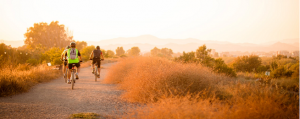With organised sport on hold due to COVID-19, Australians turned to running, riding, and yoga to stay active and socially connected.
Dancing takes centre stage for kids with sports on pause during early stages of pandemic
According to Sport Australia’s latest AusPlay survey results that identify sport and physical activity habits across the country.
The results, which focus on the early impact of COVID-19 on sport and physical activity participation and includes data from Sport Australia’s other survey tool, the Community Perceptions Monitor, also found children bore the brunt of the sport shutdown.
Sport Australia Acting CEO Rob Dalton said AusPlay was an important way to track how Australians engage with sport and physical activity, while the Community Perceptions Monitor captured public attitudes towards various aspects of sport.
Mr Dalton said:
“We know COVID-19 has had a huge impact on our ability to be active and participate in organised sport. Not only did Australians change how and how often they were physically active, but their reasons for doing so changed as well, with more participants moving for mental health and social reasons.”
Mr Dalton said the research also highlights the important role sport can play in bringing communities together and lifting the nation’s energy and spirits.
Mr Dalton said:
“Almost half (44 per cent) of Australians said they missed sport being in their life and 57 per cent of adult participants were looking forward to being able to play their chosen sport again.”
“Those who found it easier during the sports shutdown to remain active and engaged in physical activity reported feeling a greater sense of wellbeing, optimism and connection, which serves to demonstrate the crucial role that sports can play in the national recovery from the pandemic.”
The lockdown also affected children more than adults. Some 73 per cent of Australian adults continued to be active during lockdown compared with just 17 per cent of children still able to take part in organised physical activities outside of school, according to AusPlay. Dancing, some of which could be done online, was the children’s activity with highest continuation during this time, followed by tennis and football/soccer.
It’s a big leap from the previous year, where pre-COVID, more than three-quarters (76.1 per cent) of Australian children participated in organised outside-of-school sport or physical activity.
Mr Dalton added:
“With organised sport on hold these figures make sense and that’s why successfully rebooting children’s organised sport is crucial. We need to get kids moving again and meeting the recommended one hour of physical activity a day.”
When it came to getting back on the field the most common concerns were health-related, including being around people who may not follow health rules, whether clubs could operate and the impact of the shutdown on fitness and skill levels. Those adults expressed similar sentiment towards their children returning to sport in the Community Perceptions research.
By August, roughly one-third of adults (38 per cent) and children (39 per cent) who expected to play at least one organised sport between April and December had returned to all their sports including a very small number who were actually playing more.
Dalton said:
“Sports are now facing another big challenge – getting participants and volunteers back, but you can help. Join a local team or volunteer your time. We can all play a role to help sport not just survive but thrive again.”
Minister for Youth and Sport, Senator the Hon Richard Colbeck said it was a priority of the Australian Government to continue supporting sport as the nation navigates the ongoing challenges of COVID-19.
Minister Colbeck said:
“The report clearly illustrates the impact the pandemic has had on the nation’s sports participation and physical activity, and there is no doubt sport will play a prominent role in leading our recovery.
“This is an unprecedented challenge, but we are getting on with the job of supporting sport. With over 13 million participating in organised sport each year, it is an essential part of Australian life.
“The Australian Government, through Sport Australia, is committed to ensuring sport comes through this period in the best position it can. Our sports have been engaged regularly to understand and support their needs as much as possible, and for some it will be a long recovery process. Outside of funding there are a range of services and initiatives available and under development at Sport Australia that will provide invaluable assistance in this process.”
AusPlay provides the sport sector with vital insights into the physical activity behaviours of adults and children and critical evidence to inform strategies to grow participation.
AusPlay recently passed the milestone of 100,000 telephone interviews conducted with Australian adults across all states and territories since its launch in October 2015.
Top 3 children’s activities with highest continuation during lockdown*:
- Dancing (including jazz and ballet), 35.8 per cent
- Tennis, 27.0 per cent
- Football/soccer, 23.2 per cent
* Participants in the last 12 months who continued in the activity in the seven days prior to interview during the COVID-19 lockdown from April–June 2020.
Top 5 activities adults participated in more^:
- Jogging, 41.8 per cent
- Running, 41.0 per cent
- Yoga, 38.6 per cent
- Exercise at home, 37.9 per cent
- Bike riding/cycling, 36.1 per cent
^ Participants who continued with each activity in the seven days prior to interview and participated more due to COVID-19 (April-June 2020). For example, 41.8% of joggers who participated in the week prior to interview jogged more than usual due to COVID-19.
Community Perceptions data also shows:
- Adults said they had deliberately been more active in April, around the time that restrictions were first put in place.
- Most Australians (over two-thirds) returned to at least one of their organised sports once it resumed (up to August 2020), however participation and volunteering rates remain lower than what had been forecasted prior to the pandemic.
Read the full report at clearinghouseforsport.gov.au/research/ausplay/results



